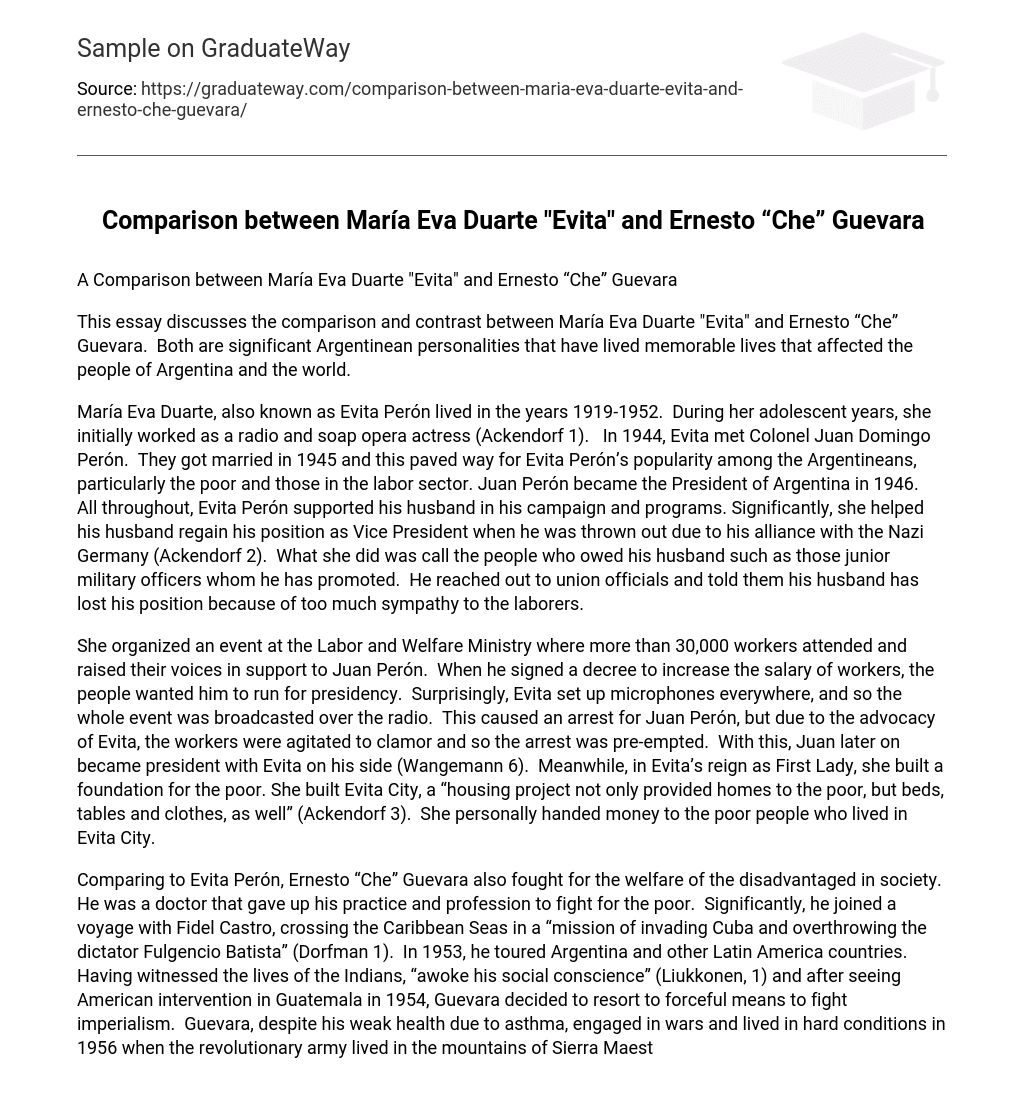A comparison is being made between María Eva Duarte, who is also known as Evita, and Ernesto “Che” Guevara.
This essay examines the comparison and contrast between María Eva Duarte, also known as Evita, and Ernesto “Che” Guevara. Both individuals are prominent Argentinean figures whose impactful lives have influenced both the people of Argentina and the world.
María Eva Duarte, also known as Evita Perón, lived from 1919 to 1952. She began working as a radio and soap opera actress during her teenage years (Ackendorf 1). In 1944, Evita met Colonel Juan Domingo Perón and they were married in 1945. This led to Evita Perón’s popularity, especially among the poor and laborers in Argentina. In 1946, Juan Perón became the President of Argentina with Evita’s support in his campaign and programs. Importantly, Evita played a crucial role in helping her husband reclaim his position as Vice President after being ousted due to his alliance with Nazi Germany (Ackendorf 2). She contacted individuals who owed her husband favors, such as junior military officers he had promoted, as well as union officials, informing them that his loss of position was a result of showing too much sympathy towards laborers.
During an event organized at the Labor and Welfare Ministry by Evita, more than 30,000 workers gathered to show their support for Juan Perón. The workers raised their voices in support of Perón, and their numbers and enthusiasm prompted a decree to increase worker salaries, boosting Perón’s popularity. In a surprising move, Evita strategically placed microphones throughout the venue, ensuring that the entire event was broadcasted over the radio. Unfortunately, this led to Perón’s arrest. However, thanks to Evita’s advocacy and the agitation of the workers, the arrest was thwarted. Eventually, Perón became president with Evita by his side (Wangemann 6).
During her time as First Lady, Evita established a support system for the impoverished by creating Evita City. This housing project not only offered shelter but also included essential furniture and clothing for its residents (Ackendorf 3). Additionally, she personally distributed funds to the individuals living there.
Ernesto “Che” Guevara, like Evita Perón, fought for the betterment of the less privileged. A former doctor, Guevara abandoned his profession to champion the cause of the poor. He embarked on a journey alongside Fidel Castro, crossing the Caribbean Seas with the aim of overthrowing dictator Fulgencio Batista and liberating Cuba (Dorfman 1). In 1953, he toured Argentina and other Latin American countries, where he witnessed the struggles of indigenous people, which ignited his social awareness (Liukkonen 1). Guevara was motivated to use forceful tactics against imperialism after witnessing American intervention in Guatemala in 1954. Despite his asthma and delicate health, Guevara participated in wars and endured harsh conditions while living with the revolutionary army in Cuba’s Sierra Maestra mountains in 1956. His speeches denouncing imperialism and US policies in Third World countries garnered significant attention in 1959 (Liukkonen 1). Although he briefly served as Cuba’s Minister for Industries, Guevara eventually relinquished his political position to put his revolutionary theories to the test (Liukkonen 1). Tragically, he was killed by Bolivian rangers during his training of guerilla warfare in Bolivia.
Both Evita and Che fought for the rights of the poor, albeit in divergent manners. Evita utilized her charisma and compassion to establish foundations aimed at aiding the less fortunate, providing financial support to those in need. In contrast, Che resorted to guerrilla warfare and employed his writings to combat capitalism and imperialism. He produced articles and personal chronicles on the subject, firmly believing that drastic measures and a violent revolution were necessary for effecting change (Liukkonen, 1).
Both Evita and Che lived in the same era, but their approaches to fighting oppression differed. Evita, being a woman, had to work behind her husband to ensure he stayed in power so she could help others. On the other hand, Che found a way to assert his own authority and fought oppression through conventional means that were expected of a man – through forceful measures.
Works Cited
Ackendorf, J. (2009, January 22). Maria Eva Duarte De Peron. Associated Content. Retrieved March 24, 2009 from [insert URL here].
Wangemann (2005) states that the article “Evita the Woman” can be found on Execpc.com. It was published on October 5, 2005 and retrieved on March 24, 2009.
Dorfman (2009) states that Che Guevara still represents rebellion and the intense passion of revolution, despite communism potentially losing its fervor. The information was obtained on March 24, 2009 from http://www.time.com/time/time100/heroes/profile/guevara01.html .
On March 24th, 2009, I visited the website http://kirjasto.sci.fi/guevar.htm which contains information about Ernesto (Che) Guevara de la Serna.





